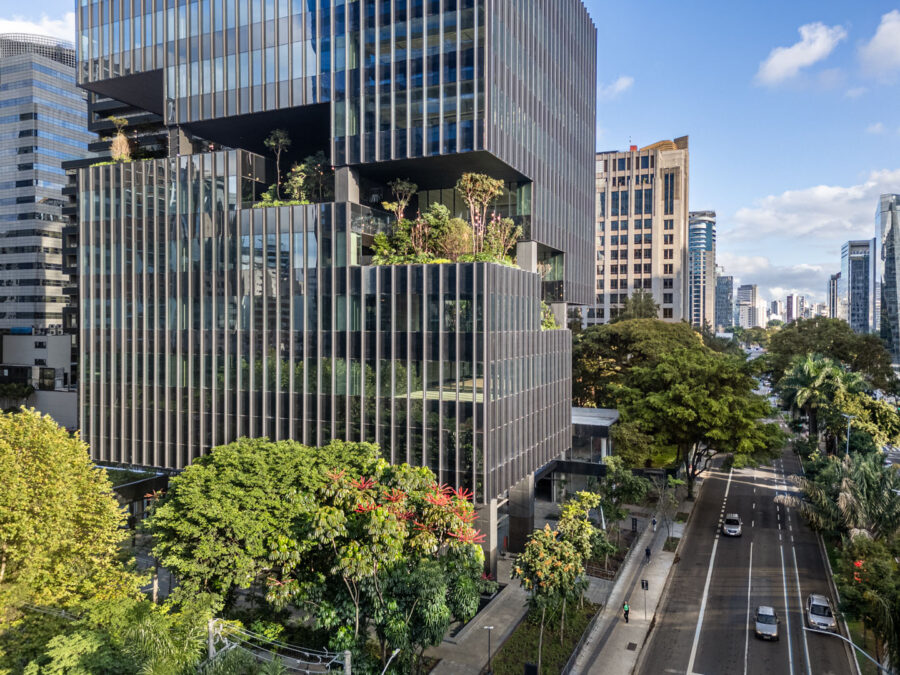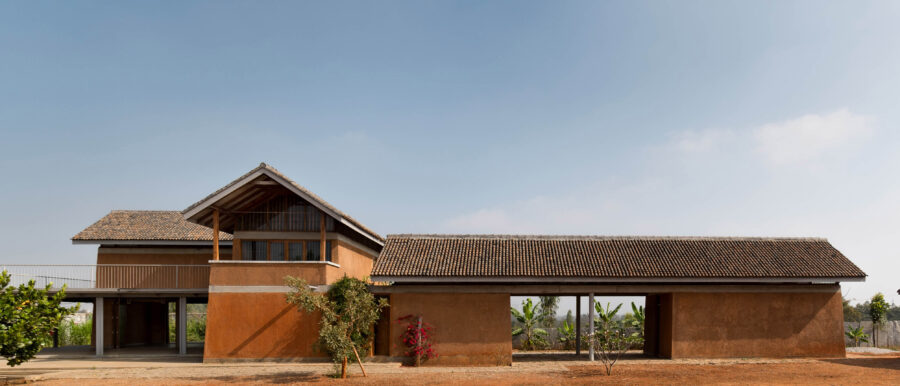
CULTURE


Photo by Arch Exist

Photo by Arch Exist
中国、成都の川に架かる〈絳渓河橋(Jiangxi River Bridge)〉はザハ・ハディド・アーキテクツ(Zaha Hadid Architects)が設計した、シンメトリーなアーチで構成された全長295mの彫刻的な橋です。
道路の両脇から立ち上がる高さ30mのアーチが互いに傾きつつ中央で接することで横方向からの強風に対応した、中央部の185mというスパンに最適化した構造となっています。
(以下、Zaha Hadid Architectsから提供されたプレスキットのテキストの抄訳)

Photo by Arch Exist

Photo by Liang Xue
成都の西線道路(West Line Road)に計画されている一連の橋における最初の橋となる全長295mの〈絳渓河橋〉は、中国四川省東部を流れる沱江の支流である絳渓河に架かっている。
185mの中央スパンと55mの副スパンからなる、自動車、自転車、歩行者用のこの橋が開通することで、西線道路をエアポートニュータウンの環状道路とサイクリングルートの西側区間とする。

Photo by Arch Exist

Photo by Liang Xue
シンメトリーな曲線で構成された彫刻的な橋
このシンメトリーな橋は、道路脇の両側から立ち上がる2つのスチール製のアーチで構成されている。
これらのアーチは上昇するにつれて互いに傾き、その頂点にて接線方向に接し、横方向の強風から構造を安定させており、120~250mのスパンに対して最も効率的な橋梁構造を実現している。
橋を支えるダイナミックな曲率の橋脚と橋台は、主要なアーチと道路デッキに向かって細くなり、成都の交通インフラにおける彫刻的なランドマークとなっている。

Photo by Liang Xue

Photo by Liang Xue
コンペ時のビジュアルを実現する構造設計と施工計画
ザハ・ハディド・アーキテクツは、2019年に開催された設計コンペにより橋の建設を依頼され、デジタルモデルに構造解析ソフトウェアを組み込み設計を行った。
すべての材料の自重などによる死荷重や交通活荷重に加え、風や温度などの環境を考慮した解析を行い、構造と基礎が200年に一度の気象現象に必要な基準を超えていることが確認された。

Photo by Arch Exist

Photo by Liang Xue
高さとスパンの比がおよそ1:6であるこの橋のアーチは高さ30mまで上昇し、道路デッキの端に沿って走る縦方向の箱桁によって基部で結合されている。これらのつなぎ目は、各アーチの外向きの水平スラストに抵抗し、橋の基礎にかかる水平荷重を大幅に軽減する。
橋の両端のコンクリート橋台には、道路デッキと西線道路の路面をつなぐコネクターが組み込まれている。また、絳渓河には基礎がないため、中間に配された橋脚は各河岸のアーチのスプリングポイント(アーチ形状が開始する点)より下に配置されている。

Photo by Arch Exist
橋のボーリング杭と橋台は、従来の現場打ち鉄筋コンクリート工法で建設された。
一方、各アーチのスチールボックス部分は、輸送と現場での組み立てのために最適な寸法でプレファブ化された。道路デッキ内の端部箱桁部分にはケーブル・アンカーが含まれており、これらもプレファブで製作され、現場で溶接して接合するために分割して搬入された。

Photo by Arch Exist

Photo by Liang Xue

Photo by Liang Xue





以下、Zaha Hadid Architectsのリリース(英文)です。
Project: Jiangxi River Bridge
Location: Chengdu, China
Date: 2019 / 2023
Client: Chengdu International Aerotropolis Group Construction and Development
Status: Built
Size: 13,860 m²Architect: Zaha Hadid Architects (ZHA)
Design: Patrik Schumacher
ZHA Project Directors: Charles Walker, Lei Zheng, Ed Gaskin
ZHA Project Architect: Han-Hsun Hsieh
ZHA Site Team: Lei Zheng, Han-Hsun Hsieh
ZHA Project Team: Jan Klaska, Lei Zheng, Marina Dimopoulou, Stratis Georgiou, Hung- Da Chien, Han-Hsun Hsieh, Martha Masli, Stella Dourtmes, Charles Walker, Ed Gaskin
Executive Architect: China Southwest Architectural Design & Research Institute
Local Architect: China Southwest Architectural Design & Research Institute
Structural Engineers: Buro Happold, China Southwest Architectural Design & Research Institute
Quantity Surveyor: China Southwest Architectural Design & Research Institute
General Contractor: Sinohydro Bureau 7 China Huaxi Engineering Design and Construction
Environmental Consultant: Shenzhen Pengdaxin Energy Environmental Protection Technology
M&E Engineering: China Southwest Architectural Design & Research Institute
MEP: China Southwest Architectural Design & Research Institute
Transport Consultant: China Southwest Architectural Design & Research Institute
Fire Engineer: China Southwest Architectural Design & Research Institute
Landscape Consultant: Zaha Hadid Architects
Lighting Design: Zaha Hadid Architects
Site Supervision: China Huaxi Engineering Design and Construction
Total Bridge Length: 295m
Central Span: 185m
Secondary Spans: 55m
Height of Arches: 30mThe first in a series of bridges on Chengdu’s West Line Road, the new 295-metre Chengdu West First Bridge crosses the Jiangxi River, a tributary of the Tuojiang River in China’s Sichuan province.
With its 185-metre central span and 55-metre secondary spans reaching to the riverbanks, the Chengdu West First Bridge is a road, cycle and pedestrian bridge over the meandering Jiangxi River; enabling the West Line Road to become the western section of the Airport New Town ring-road and cycle route.
As arches provide the most efficient bridge structure for spans between 120-250 metres, this symmetrical bridge is composed of two primary steel arches that rise from either side of the road deck. As they rise, the arches lean together to touch tangentially at their crown, stabilising the structure from lateral wind forces.
The dynamic curvature of the bridge’s supporting piers and abutments taper into its primary arches and road deck, defining a sculptural landmark within Chengdu’s transport infrastructure.
Commissioned to build the bridge following the 2019 design competition, Zaha Hadid Architects (ZHA) used structural analysis software on the design’s digital model. Examining all material self-weight, superimposed dead load and traffic live loading, as well as environmental considerations of wind and temperature, this analysis ensured the structure and foundations have been designed to exceed the standards required for once-in-200-year weather events.
With a height to span ratio of approximately 1:6, the bridge’s arches rise to 30 metres and are tied together at their base by longitudinal box girders that run along the edge of the road deck. These ties resist the outward horizontal thrust of each arch and significantly reduce the horizontal loads on the bridge’s foundations.
Concrete abutments at either end of the bridge incorporate connectors linking the road deck to the West Line Road’s surface. With no foundations positioned in the Jiangxi River, intermediate piers are located beneath the springing points of the arches on each riverbank.
The bridge’s bored piles and abutments were constructed using conventional in-situ reinforced concrete techniques. The steel box sections of each arch were prefabricated in optimal dimensions for transportation and assembly on site. The edge box girder sections within the road deck include the cable anchorages. These sections were also prefabricated and delivered in sections to be spliced together with on-site welding.
The bridge’s prefabricated plate cross girders were delivered to the site and connected to the edge girders by a bolted cover plate splice connection. The concrete road deck has been constructed from precast panels fixed to the cross girders by in-situ concrete stich pours.
Mobile cranes lifted all prefabricated steelwork and precast concrete elements within the bridge’s short assembly schedule.
「Jiangxi River Bridge」Zaha Hadid Architects 公式サイト
https://www.zaha-hadid.com/2023/08/16/zha-completes-jiangxi-river-bridge-in-chengdu/









